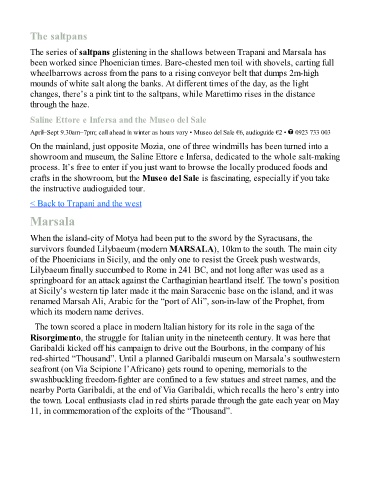Page 524 - The Rough Guide of Sicily
P. 524
The saltpans
The series of saltpans glistening in the shallows between Trapani and Marsala has
been worked since Phoenician times. Bare-chested men toil with shovels, carting full
wheelbarrows across from the pans to a rising conveyor belt that dumps 2m-high
mounds of white salt along the banks. At different times of the day, as the light
changes, there’s a pink tint to the saltpans, while Marettimo rises in the distance
through the haze.
Saline Ettore e Infersa and the Museo del Sale
April–Sept 9.30am–7pm; call ahead in winter as hours vary • Museo del Sale €6, audioguide €2 • 0923 733 003
On the mainland, just opposite Mozia, one of three windmills has been turned into a
showroom and museum, the Saline Ettore e Infersa, dedicated to the whole salt-making
process. It’s free to enter if you just want to browse the locally produced foods and
crafts in the showroom, but the Museo del Sale is fascinating, especially if you take
the instructive audioguided tour.
< Back to Trapani and the west
Marsala
When the island-city of Motya had been put to the sword by the Syracusans, the
survivors founded Lilybaeum (modern MARSALA), 10km to the south. The main city
of the Phoenicians in Sicily, and the only one to resist the Greek push westwards,
Lilybaeum finally succumbed to Rome in 241 BC, and not long after was used as a
springboard for an attack against the Carthaginian heartland itself. The town’s position
at Sicily’s western tip later made it the main Saracenic base on the island, and it was
renamed Marsah Ali, Arabic for the “port of Ali”, son-in-law of the Prophet, from
which its modern name derives.
The town scored a place in modern Italian history for its role in the saga of the
Risorgimento, the struggle for Italian unity in the nineteenth century. It was here that
Garibaldi kicked off his campaign to drive out the Bourbons, in the company of his
red-shirted “Thousand”. Until a planned Garibaldi museum on Marsala’s southwestern
seafront (on Via Scipione l’Africano) gets round to opening, memorials to the
swashbuckling freedom-fighter are confined to a few statues and street names, and the
nearby Porta Garibaldi, at the end of Via Garibaldi, which recalls the hero’s entry into
the town. Local enthusiasts clad in red shirts parade through the gate each year on May
11, in commemoration of the exploits of the “Thousand”.

